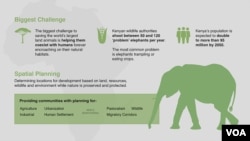World Elephant Day was Friday, Aug. 12, and one of the biggest challenges to saving the world’s largest land animals is helping them coexist with humans forever encroaching on their natural habitats.
It’s not the most exciting topic in the world of conservation, but it could end up being one of the most critical. It’s called spatial planning.
“By this, I mean, land can be used for agriculture, land can be used for environment conservation, basically protection and preservation of nature and not really just conserving it for the sake of it, but for people to be able to use ," said Maritim . " It can be used for urbanization and human settlement and it can also be used for industrial development. It can be used for pastoralism, wildlife ranges, and migratory corridors and stuff like this.”
Zachary Maritim is the spatial planning manager at the World Wildlife Fund in Kenya.
Kenya’s population is expected to double to more than 95 million by 2050. With such rapid growth, it is necessary to plan for the future.
“And this process is participatory," said Maritim . "You cannot do it as expert-driven because the constitution now requires that these land use planning processes are done by public participation.”
And environmental conservation benefits the community, says Titus Musungu, an assistant director of planning for the Kenya Ministry of Lands and Physical Planning.
He says people often already understand this connection, but just need some technical assistance. He uses their work in Narok County as an example, home of the famous Masai Mara.
“We only try to deepen their actual understanding by using tools such as maps so that they are able to map their own resources," said Musungu . "They are able to see the central role that Masai Mara plays…and they can utilize that land sustainably by sharing it with the animals and being able to still utilize it for their own purposes, and at the same time, being able to attract touristic sort of investment.”
The WWF says Kenyan wildlife authorities shoot between 50 and 120 ‘problem’ elephants per year. The most common problem is elephants trampling or eating crops.
Through collaborative planning and other initiatives, many are hoping to reduce this conflict in the future.













